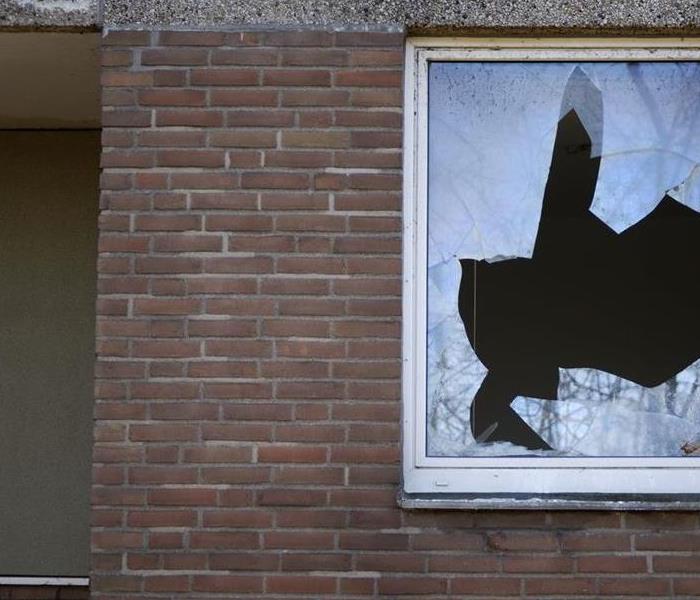Archived Storm Damage Blog Posts
How to Make Sure Your Business is Safe and Prepared for Winter Weather
10/16/2024 (Permalink)
As winter approaches in Pennsylvania, businesses in Newtown, Yardley, and New Hope need to take proactive steps to ensure their properties, employees, and customers are safe from the challenges that winter weather can bring. From heavy snowfalls to icy conditions and freezing temperatures, the winter season can pose significant risks. Here are some key steps to help your business stay safe and prepared for whatever winter brings.
- Inspect and Maintain Heating Systems
One of the first things to do as winter nears is to check your heating system. Have a professional inspect your HVAC system to ensure it's in good working condition. Replace filters, check for leaks in ducts, and ensure that all heating equipment is functioning efficiently. Regular maintenance can prevent unexpected breakdowns during a cold snap and reduce energy costs.
- Prepare for Power Outages
Winter storms can often result in power outages. Ensure your business is prepared by having a backup generator in place. Test the generator regularly to make sure it is operational when needed. Stock up on essential supplies like batteries, flashlights, and extra blankets, and consider investing in battery-powered chargers for essential devices. Create a communication plan for notifying employees and customers in the event of a power outage.
- Prevent Ice Dams and Roof Damage
Pennsylvania winters are notorious for their heavy snowfalls and icy conditions. Ice dams, caused by melting snow refreezing at the roof's edge, can lead to significant water damage inside your building. Ensure your roof is well-insulated and ventilated to prevent heat from escaping and melting snow on the roof. Keep gutters clear of debris to allow for proper drainage, and consider using heat cables on the roof's edge to prevent ice buildup.
- Maintain Walkways and Parking Lots
Slip-and-fall accidents are a major concern during winter months. Keep walkways, entryways, and parking lots clear of snow and ice. Use salt, sand, or de-icing products to keep these areas safe. Consider hiring a professional snow removal service to handle heavy snowfall. Regularly check for ice patches and remove them promptly to protect both employees and customers.
- Ensure Proper Ventilation
In winter, businesses often close windows and doors to keep the cold out. However, proper ventilation is crucial to prevent the buildup of indoor pollutants and maintain air quality. Ensure your ventilation systems are working effectively and consider air purifiers if necessary. Encourage employees to take regular breaks outside if possible, to get fresh air and avoid spending extended periods in poorly ventilated areas.
- Protect Your Pipes from Freezing
Frozen pipes can burst and cause extensive water damage to your business premises. Insulate exposed pipes, especially those in unheated areas like basements or attics. Keep a minimum temperature in your building, even when it's unoccupied, to prevent pipes from freezing. Educate employees on the location of shut-off valves so they can act quickly in case of a burst pipe.
- Review Your Emergency Plan
Winter weather can be unpredictable, so it’s vital to have a comprehensive emergency plan in place. Review and update your plan regularly, ensuring it includes procedures for severe weather events, such as blizzards or ice storms. Make sure all employees are familiar with the emergency protocols and know how to respond to different situations. Conduct regular drills to reinforce these plans and ensure everyone is prepared.
- Stock Up on Essential Supplies
Keep an adequate stock of essential supplies, including first aid kits, non-perishable food, bottled water, blankets, and ice melt. These supplies can be invaluable in case of severe weather or if your business is temporarily cut off from outside help. Ensure that employees know where these supplies are stored and how to access them in an emergency.
- Secure Outdoor Equipment and Furniture
High winds and heavy snow can damage outdoor equipment and furniture. Secure or store any items that could be blown away or damaged by winter weather. If your business uses vehicles, ensure they are winter-ready with proper tires, wipers, and emergency kits. Regularly check the condition of outdoor signage, lighting, and other fixtures that could be impacted by harsh weather.
- Communicate with Employees and Customers
Clear communication is key during winter months. Keep employees informed about weather forecasts, potential closures, or delays. Use multiple channels, such as email, text, and social media, to update customers about your business hours and any changes due to winter weather. Being proactive with communication can help manage expectations and maintain trust.
By taking these steps, your business can be better prepared to face the challenges of a Pennsylvania winter. From maintaining your heating system to ensuring safe walkways and preparing for power outages, a little preparation can go a long way in keeping your business safe and operational throughout the season. Remember, SERVPRO of Newtown, Yardley, and New Hope is here to help with any winter-related damage or emergencies. Stay safe and prepared this winter!
How to Prepare Your Home for Spring Flooding
5/31/2024 (Permalink)
Spring in Southeastern Pennsylvania is a beautiful time of year, with blooming flowers and warming temperatures. However, it also brings the risk of spring flooding due to heavy rains.
Flooding can cause significant damage to your home, but by taking preventive measures, you can minimize the risk and protect your property. At SERVPRO of Newtown/Yardley/New Hope, we're committed to helping you stay safe and prepared. Here’s how you can prepare your home for spring flooding.
Preventive Measures to Minimize Flood Damage
- Inspect and Maintain Your Gutters and Downspouts
- Clear Debris: Remove leaves, twigs, and other debris from gutters to ensure proper water flow.
- Check for Leaks: Repair any leaks or damaged sections to prevent water from spilling over and pooling near your home’s foundation.
- Extend Downspouts: Ensure downspouts direct water at least 10 feet away from your home to prevent foundation saturation.
- Landscape with Flooding in Mind
- Grade Your Yard: Ensure the ground slopes away from your home’s foundation to direct water away.
- Install a Rain Garden: Use native plants to absorb excess water in low-lying areas of your yard.
- Mulch Wisely: Use heavy mulch to prevent soil erosion but avoid blocking drainage paths.
- Seal Your Home’s Foundation and Basement
- Apply Sealants: Use waterproof sealants on your foundation walls and basement floors to prevent water seepage.
- Install a Sump Pump: Ensure your sump pump is functioning correctly and consider installing a battery backup in case of power outages.
- Check Your Roof and Windows
- Inspect Your Roof: Look for missing or damaged shingles and repair them to prevent leaks.
- Seal Windows and Doors: Check for and repair any gaps or cracks around windows and doors to keep water out.
- Install Flood Sensors and Backup Power
- Flood Sensors: Install flood sensors in your basement and other flood-prone areas to get early warnings of water intrusion.
- Backup Power: Consider a generator to keep your sump pump and other critical systems running during power outages.
Flood Preparedness Checklist
- Emergency Kit
- Essentials: Stock up on bottled water, non-perishable food, medications, and first-aid supplies.
- Tools and Supplies: Have a flashlight, batteries, a multi-tool, and a portable phone charger.
- Important Documents
- Waterproof Storage: Keep important documents like insurance policies, birth certificates, and passports in a waterproof container.
- Digital Copies: Store digital copies of essential documents in a secure, cloud-based service.
- Evacuation Plan
- Plan Routes: Know multiple evacuation routes in case primary paths are flooded.
- Family Communication: Establish a communication plan with family members to stay in touch during an emergency.
- Protect Electrical Systems
- Elevate Appliances: Raise electrical appliances and systems, such as your furnace and water heater, above potential flood levels.
- Turn Off Utilities: Know how to safely turn off your gas, electricity, and water in case of flooding.
- Secure Outdoor Items
- Remove or Anchor: Bring outdoor furniture, grills, and other items indoors or secure them to prevent them from being washed away or causing damage.
- Review Insurance Coverage
- Flood Insurance: Ensure you have adequate flood insurance and understand what is covered. Regular homeowner’s insurance typically does not cover flood damage.
By taking these preventive measures and following our flood preparedness checklist, you can significantly reduce the risk of flood damage to your home. However, if the worst happens and you experience flooding, SERVPRO of Newtown/Yardley/New Hope is here to help. Our team of professionals is trained and equipped to handle water damage restoration quickly and efficiently, ensuring your home is returned to its pre-flood condition as soon as possible.
Stay safe this spring, and don’t hesitate to reach out to us for any of your restoration needs. Together, we can weather any storm.
SERVPRO of Newtown/Yardley/New Hope – Faster to Any Size Disaster
SERVPRO's 11 Winter Storm Preparation Tips for Homeowners
9/7/2022 (Permalink)
Winter is coming, and with it comes the risk of winter storms. These storms can cause power outages, water damage, and other hazards. That's why it's important for homeowners to take steps to prepare for them. SERVPRO is here to help! In this blog post, we will discuss 11 tips that will help you prepare for winter weather. Follow these tips and you'll be ready for anything that winter throws your way!
Tip 1 - Have an emergency plan. This plan should include where you will go if you lose power, how you will stay warm, and what you will do if your pipes freeze.
Tip 2 - Stock up on supplies. This includes non-perishable food, water, batteries, and first aid supplies.
Tip 3 - Winterize your home. This means sealing up any cracks or gaps in your walls and windows, and insulating your pipes to prevent them from freezing.
Tip 4 - Know how (and where) to shut off your water. If your pipes freeze, you will need to shut off the water to prevent them from bursting.
Tip 5 - Have a list of emergency phone numbers. This includes the number for your local SERVPRO, as well as your utility companies.
Tip 6 - Keep your gas tank full. This will help you stay warm if you lose power and need to use your fireplace or space heater.
Tip 7 - Invest in a generator. This will provide you with power if you lose electricity.
Tip 8 - Clear your gutters and downspouts. This will prevent ice dams from forming and causing water damage to your home.
Tip 9 - Be aware of the signs of hypothermia. These include shivering, exhaustion, confusion, and slurred speech. If you see these signs, it's important to seek medical help immediately.
Tip 10 - Dress in layers. This will help you stay warm even if you can't heat your home.
Tip 11 - Have fun! Winter can be a beautiful time of year, so don't let the risk of storms ruin it for you. Get out there and enjoy the snow!
By following these tips, you can be prepared for anything that winter weather throws your way. SERVPRO of Newtown, Yardley, New Hope is here to help if you do experience any damage from a winter storm. We are always Here to Help®!
How to Fix Your Roof after a Storm
1/30/2022 (Permalink)
How to Fix Your Roof after a Storm
It's not often that disaster strikes but when it does, you want to make sure you are doing everything correctly, from start to finish. When the roof has been severely damaged by wind or hail, it can be one of the more costly repairs on your home. The main concern during this time period is safety from falling objects such as tree branches or other debris. This article is a guide for homeowners on what they should do after a storm has passed and left its wake of devastation in the form of shingles, shingles debris, and leaks that have sprung into their ceilings due to storm damage.
Now what? Whether you had a little damage or a lot of damage, a quick response is very important if you want to save your roof and reduce the potential for more leakage.
First make sure that it is safe to enter your home. If there are any toppled trees or limbs, remove those before entering the house. Once inside, if there is water in your ceilings and/or walls then it is time to call a professional roofer.
For minor damages like blocked gutters or missing shingles caused by wind gusts, wait until it stops raining and immediately check your roof with binoculars for any immediate danger of further damage such as loose tiles or hanging parts of the structure. If you have a partial shingle loss, be sure to nail down the tiles that are still attached. If your roof is in need of replacement, call for an estimate before performing any repairs or replacements yourself.
Soaking up water - Blocked gutters are the main cause of water damage when there is heavy rain over time
Removing debris - If you come across any loose tiles caused by high winds then remove them and nail down any metal ridge caps that might have popped out of place during the storm
Checking your shingles - Check with binoculars for blown off parts of the structure including missing shingles and loose tiles
Assessing the damage - Generally speaking, if there has been any shingle loss then it is time to call a professional roofer for an estimate. A restoration company will be able to tell you if you need to get a new roof or just get the one you already have restored. The restoration services like SERVPRO will tell it to you how it is. If we feel that the roof may not stand another storm we would recommend getting a new roof otherwise we will restore it for you.
Making temporary repairs for leaks in between rafters until the restoration company arrives. It is important to hire a storm damage restoration company if you want to get your roof in good condition. Don’t forget to contact your insurance company as well so you don’t have to pay much for the restoration or repair of the roof.
Tips for Repairing Storm Damage
1/30/2022 (Permalink)
Tips for Repairing Storm Damage
Storm damage can come in the form of fallen trees, roof damage, and interrupted electrical service. The good news is that most storm damage repair jobs are low-skill projects that do not require an extensive level of knowledge or experience to handle on your own.
Even a fairly small tree has the potential to cause substantial damage during a storm if it falls onto a home or other property. Fortunately, there are several steps you can take after a tree has fallen into your yard to help prevent further problems from developing.
Assess How Much Damage Has the Storm Caused
The first thing to do after a storm is to assess how much damage it has caused to your property. This will give you a good idea about how much money you might have to spend on the repairs and restoration. So it is always good to have insurance for such cases.
Contact Your Insurance Company
Check with your insurance agent before starting repairs. Insurance coverage is dependent upon the type of storm, its location and other factors. Some types of damage may not be insured.
Document all storm-related damages to your home or building using photographs or video before making any repairs. This will provide a full record of damage for future reference should it become necessary to file an insurance claim later.
Only Focus on the Things That Are Actually Damaged During the Storm
Repair only those areas that are immediately damaged; stop further damage by boarding up broken windows, covering exposed outdoor electrical wiring or gas lines, etc., as soon as possible after the event has passed. Dispose of debris promptly in order to avoid mosquito breeding sites. Keep children away from dangerous materials such as broken glass, tarp-covered tree branches and other hazards.
Seal Holes in Foundation, Roof and Siding to Stop Water from Going In
Make sure to properly repair all holes in the roof and walls due to fallen trees or wind gusts. These holes can not only let water seep in but they can create easy access points for wasps, bees and other insects that could be attracted to water inside your home's damaged walls or foundation.
Repair Tree Damage to Your Property As Soon As It's Safe to Do So
One of the best ways to prevent more damage is to get damaged trees off of your property as quickly as possible. If there is a lot of damage, it may be wise to contact an arborist for advice and assistance if needed.
Hire a Professional to help you with the restoration
Storm damage is not always an easy task to take on yourself. Hire a professional if you feel intimidated or do not have the time to deal with the cleanup and repairs your property may require after a storm. SERVPRO can help you with the restoration of your property after a storm has caused its destruction.
5 Ways to Protect Your Belongings during a Storm
12/1/2021 (Permalink)
We've all been there. You're sitting in your home, anxiously waiting to hear if the storm that is heading towards you will be a Category 2 or 3. It's not until hours later when it has passed do you go outside to survey the damage. If you were lucky, only some of your property was damaged and everything else was still intact; but if you weren't so lucky, then this article may help stop future disasters from happening again! Here are five ways to protect your belongings during a storm.
Store important documents In a Safe Place
One of the simplest and most effective ways to protect your belongings during the storm is to place them in a safe place. This will not just save your belongings from getting damaged but it will also be great if you have to rush and evacuate due to the storm warning. A great option for this would be an Under Bed Safe, which you can easily store underneath any bed or heavy piece of furniture so that no one will ever think twice about it being there. This type of safe has been known not only to lock away documents but also jewelry, money, cameras, laptops, etc.
Place any items that can be blown away, such as plants or decorations, inside of the house
If you have any items in your yard that are not too heavy, then it is best to bring them inside the house or into a garage. This includes plants, decorations, and furniture. It may be fine for these types of objects to get damaged during just one storm but if they're outside when multiple storms happen back-to-back then there's no telling how much damage can occur!
Keep appliances unplugged
If you have any appliances that are not in use, then it is best to unplug them during the storm. If they get damaged due to power surges caused by lightning or rain/snow entering through poorly-sealed doors and windows, then this can become very costly! It's also a good idea to keep all of your electronics plugged into surge protectors so that if there does happen to be an electrical problem, these items will still remain safe (just make sure they're turned off).
Make sure you have multiple flashlights/lanterns around for when there is no power available due to storms which happen often lately
This is an essential item to have in any house, especially if you live in a rural area. There are many times where the power goes out for days at a time due to storms and it can be very annoying when there's no light or heat available! To solve this problem, make sure that you always keep flashlights/lanterns with candles on hand so that you won't ever have to worry about feeling completely powerless during a storm again.
Park the Car inside the Garage So the Storm Does Not Damage It
This is a relatively small but very effective way to protect your car from damages caused by the storm. If you live in an area that gets heavy storms then it might be best just to always park inside of your garage during such times so that there will no longer be any chance of water, hail, and/or fallen branches damaging it!
These are some great ways for how to care for your belongings during a storm which should hopefully stop future disasters from happening again.
How to Fix Your Roof after a Storm
12/1/2021 (Permalink)
It's not often that disaster strikes but when it does, you want to make sure you are doing everything correctly, from start to finish. When the roof has been severely damaged by wind or hail, it can be one of the more costly repairs on your home. The main concern during this time period is safety from falling objects such as tree branches or other debris. This article is a guide for homeowners on what they should do after a storm has passed and left its wake of devastation in the form of shingles, shingles debris, and leaks that have sprung into their ceilings due to storm damage.
Now what? Whether you had a little damage or a lot of damage, a quick response is very important if you want to save your roof and reduce the potential for more leakage.
First make sure that it is safe to enter your home. If there are any toppled trees or limbs, remove those before entering the house. Once inside, if there is water in your ceilings and/or walls then it is time to call a professional roofer.
For minor damages like blocked gutters or missing shingles caused by wind gusts, wait until it stops raining and immediately check your roof with binoculars for any immediate danger of further damage such as loose tiles or hanging parts of the structure. If you have a partial shingle loss, be sure to nail down the tiles that are still attached. If your roof is in need of replacement, call for an estimate before performing any repairs or replacements yourself.
Soaking up water - Blocked gutters are the main cause of water damage when there is heavy rain over time
Removing debris - If you come across any loose tiles caused by high winds then remove them and nail down any metal ridge caps that might have popped out of place during the storm
Checking your shingles - Check with binoculars for blown off parts of the structure including missing shingles and loose tiles
Assessing the damage - Generally speaking, if there has been any shingle loss then it is time to call a professional roofer for an estimate. A restoration company will be able to tell you if you need to get a new roof or just get the one you already have restored. The restoration services like SERVPRO will tell it to you how it is. If we feel that the roof may not stand another storm we would recommend getting a new roof otherwise we will restore it for you.
Making temporary repairs for leaks in between rafters until the restoration company arrives. It is important to hire a storm damage restoration company if you want to get your roof in good condition. Don’t forget to contact your insurance company as well so you don’t have to pay much for the restoration or repair of the roof.
How to Prepare Your Home for Natural Disasters
8/11/2021 (Permalink)
Your home is a central aspect of your life. It is your own personal space that you share with your loved ones, such as your parents, siblings, spouse, or children. Your home is where most of your dearest memories are made and you probably want to protect it forever.
However, natural disasters are common. They can wipe away all the memories you have made in your beautiful home in a split second if you are not adequately prepared for the disaster.
Preparing for a Hurricane
One natural disaster that combines many different disasters is a dangerous hurricane. It can bring heavy rainfall, winds that are faster than 150 MPH, extreme thunderstorms, and even flash floods in areas that are near the coastline.
In the US, hurricanes are especially common between June to November and it is important to prepare for them accordingly.
Hazards of a Hurricane
When a hurricane hits your area, there are many hazards that you need to look out and prepare for. These include
- Storms: A dangerous storm can affect both human life and property in just a few minutes. In the surge of a hurricane, ocean water is pushed towards the coast. When combined with the high, swirling winds, such storms can cause major damage to the structure of your home.
- 2. Winds: Hurricanes don’t have normal winds. Instead, the wind is as fast as 150 MPH and has a swirling direction. This can easily destroy entire buildings or cause irreparable damage to the foundational structure of the building.
- Heavy Rainfall and Floods: When a hurricane hits, it is accompanied by tropical storms that can bring rainfall of more than 6 inches. As the water builds, there can be flash flooding in low-lying coastal areas. This is extremely dangerous for people who live in the inlands, especially because they may not have sufficient time to evacuate in such situations.
Hurricane and Natural Disaster Preparation Guidelines
Here are a few things you can do beforehand in order to minimize the damage caused by hurricanes or other natural disasters in your area:
- Assess Your Home
Before you start taking any precautions to prepare for a hurricane, it is important to first analyze the risks of your own home. You can check with contractors or damage repair companies to ask whether the foundational structure and landscaping of your home will be able to survive heavy winds and storms. After the inspection, you may be required to have a few repairs made in your home to make the structure sturdier.
- Removal of Debris and Garbage
Since storms and hurricanes come with intense winds, it is important to remove any dead trees or garbage material such as logs of wood that could be blown into your house due to extreme wind pressure.
- Make an Evacuation Plan and Kit
If you live in a low-lying coastal area, it is important to have an evacuation plan in place that all of your family members are aware of. Apart from the plan, you also need to prepare a kit that must be equipped with food and water supplies, essential medication, a first-aid kit, and a battery-powered flashlight.
Steps To Take After Storm Damage
8/11/2021 (Permalink)
A storm can be quite scary and having to deal with its after-effects is challenging. It can leave behind a lot of damage that you will have to take care of. For this reason, you need to have all the right steps in front of you so that you can restore your home as quickly as possible. Here are 5 steps that you will have to follow after suffering from storm weather damage.
Check How Much Damage Is Done
Before you go on to figuring out the solution for the damage, you will have to assess how much damage took place. It is best to take a look at every nook and corner of your home to know where all the damage is.
Don’t miss out on anything as you want to ensure that every bit of damage is repaired properly. Observe every inch of the exterior so that you can know exactly what went wrong. Also, if there is seepage or any other time of damage as well, then make sure to take note of this as well.
Keep Yourself Safe And Avoid Injury
As you go about assessing your home of damage, you want to make sure that you avoid injury throughout. To do this, you will have to keep away from all sorts of electrical equipment and risky areas around your home.
If you see cracks on the roofs, then it is best that you avoid standing under or close to that particular area. The best thing to do is to make sure that your electricity is shut off to avoid getting damage from wires running through your home.
Get Your Insurance Company On Board
Throughout the process, you want to make sure that you are collecting adequate proof to show your insurance company. They will probably also send someone for a physical examination to verify your case. Keep them in the loop so that you can claim insurance for the damages that you face from the storm damage.
Limit Further Damage To Home
Sometimes, if you do not act quickly, there is a possibility of more damage happening to your home. You want to avoid this as much as possible. If there is an excessive wind blowing or water coming in, you might want to board your windows.
If you’re not sure how to do this, then you must reach out to a professional service for help. And, that is our final step that will help with the damage.
Get The Right Professional Cleaning Service
You want to ensure that your home is not damaged beyond repair. This is when you need to get the right people on board to help you clean up the mess after the storm weather damage. You do not want to put the entire work on yourself as you might not have the right equipment to get this done properly.
You should reach out to professionals who can help you clean your home and minimize the damage done to your home. Connect to SERVPRO of Newton / Yardley / New Hope and get your home cleaned up in no time.
5 Things To Expect During Storm Damage Restoration
4/5/2021 (Permalink)
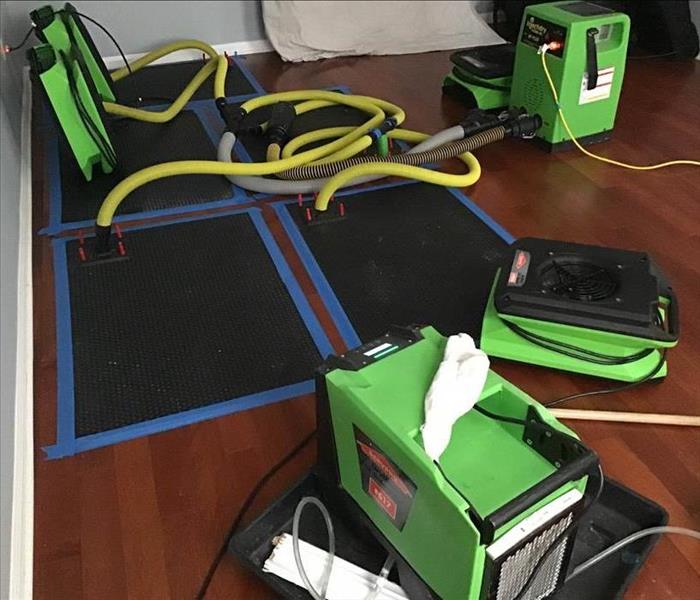 Drying the building prevents secondary water damage.
Drying the building prevents secondary water damage.
The Clean-Up Process
A storm in Woodside, PA, can, unfortunately, cause problems for your business. If your commercial building has been damaged, many steps may be required to return it to its proper condition. You may need to tear out materials or rebuild certain areas. The following are five things to expect when working with a clean-up and restoration company.
1. Removing the Water
The first thing that should be done is water removal. Allowing water to remain in your building after a storm can lead to various kinds of secondary damage, including mold growth, rust and warped wood.
2. Throwing Out Damaged Materials
Depending on the amount of water inside and the severity of the damage, you may need to tear out some building materials. This usually includes highly absorbent substances, such as carpeting, insulation and drywall.
3. Drying the Building
Removing all moisture and thoroughly drying the building helps prevent secondary water damage, so it should be done as quickly as possible. To help with this step, dehumidifiers may be used. It can also be a good idea to leave doors and windows open if you can.
4. Making Repairs
If you needed to tear out materials, these must be replaced when repairs are made. The flooring may need to be redone as well. In some cases, there may be discoloration in areas affected by the water. Repainting the walls can fix this.
5. Restoring Affected Items
Along with the building, water damage can affect the objects inside. Many of these can be restored with the help of a professional service. Even items that you may consider beyond salvaging, like paper documents and artwork, can sometimes be saved. However, objects that cannot be thoroughly cleaned should be thrown out and replaced.
Storm restoration can be a lengthy process, but each step is necessary to return your building to a safe environment. Professional workers can get this done within a reasonable time frame so you can get back to business as usual.
What Are Hurricane Storm Shutters?
1/11/2021 (Permalink)
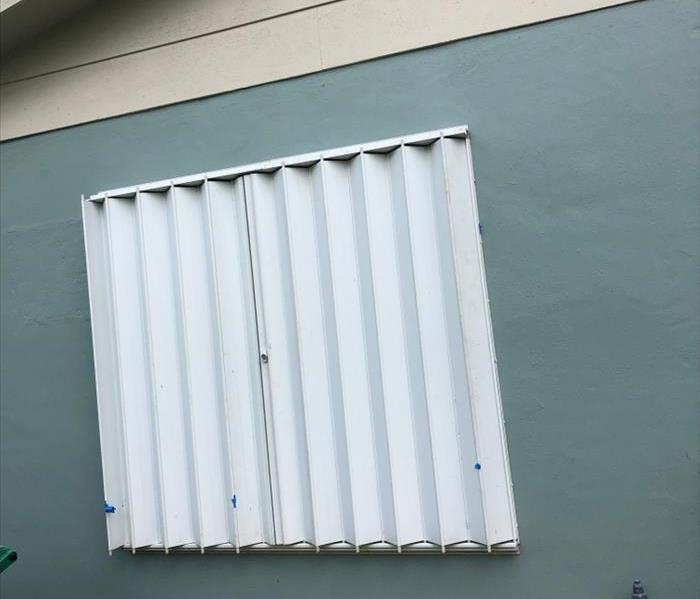 Many people invest in storm shutters for protection
Many people invest in storm shutters for protection
One of the first things people notice about a home's appearance is its shutters. Indeed, these window installations can add so much to the looks of a home that some only serve decorative purposes. In other cases, however, these home additions have a much more important role to play. In places where hurricanes occur, for example, many people invest in storm shutters for protection.
Why Have Them
If you live in a place with high winds, installing shutters on your home can be a good idea for multiple reasons, including:
- Home protection
- Personal protection
- Financial protection
In addition to keeping you, your family, and your home more secure, making this kind of investment can also save you money. Your home insurance company will likely offer you a discount when you add this layer of protection to your property because there is less of a chance you will need to call for a storm damage remediation expert.
What To Look For
When you look at shutter options, you will want to pay attention to the impact-resistant ratings as well as the testing standards applied to each product. Some storm shutters will protect better against high winds than others. For example, you might find the colonial type more stylish, but the rolling kind might be better overall.
How Much They Cost
When it comes to how much storm shutters will cost, it depends on the sort of material you choose. Plywood and fabric are usually the cheapest options. If you live somewhere with milder winds, going with the lowest cost might be okay, but costs should not be the only thing to keep in mind. Rolling and accordion styles use more expensive materials, but they can offer more security.
If you live somewhere that often experiences high winds, these window additions can make a big difference in your home's security. Regardless of your budget or home's unique circumstances, there are many options available to fit your needs.
Top 5 FAQs Regarding Commercial Flooding
11/12/2020 (Permalink)
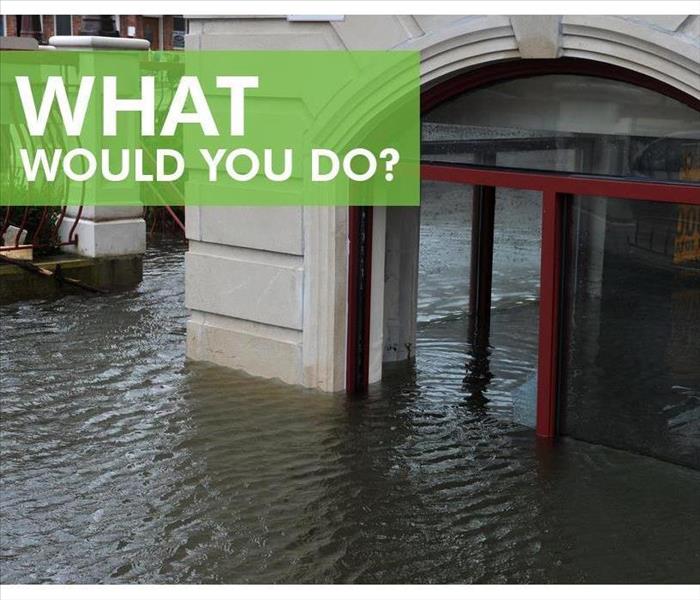 What would you do if your business flooded tomorrow?
What would you do if your business flooded tomorrow?
Prepare Yourself To Protect Your Property
It's important for all business owners to be aware of the many dangers that could afflict their commercial buildings. After all, you can't conduct business in a building full of floodwater. Study the following frequently asked questions regarding commercial floods so you can prepare yourself to protect your property in Point Pleasant, PA.
1. Is Flooding Really Something To Worry About?
According to the National Severe Storms Library, flooding is responsible for over $5 billion in commercial damages each year, making it the most expensive form of natural disaster in the country. It can also occur anywhere in the United States, making it an issue that all business owners need to watch out for.
2. Why Is Flood Water Considered Black Water?
There are three different types of flooding, each categorized by the types of contaminants present in the water itself. Black water floods are the most dangerous, as they're categorized by the presence of biohazards. If your business suffers from a category 3 flood, you need to contact professional assistance immediately.
3. How Can You Prepare for a Flood?
There are several ways to prepare your business for a flood. Some of the most important steps involve creating a disaster plan, backing up important documents, building an emergency supply kit and assessing your personal flood risk.
4. What Is Your Personal Flood Risk?
Your flood risk refers to how likely your building is to suffer from severe flood or storm damage. FEMA has several maps on its website that detail each region's personal flood risk. It's important that you take a look at these documents and commit the information to memory.
5. Why Is Professional Flood Remediation Important?
When it comes to cleaning up after a flood, the initial water damage is only the beginning. If the issue isn't resolved quickly and effectively, then you're putting your business at risk for suffering from secondary damage, such as mold growth.
Don't take risks when it comes to protecting your business from flood water damage. Contact storm remediation professionals to help resolve any flood or storm damage that has affected your commercial building.
How To Deal With Sewage Backups in Your Basement
10/21/2020 (Permalink)
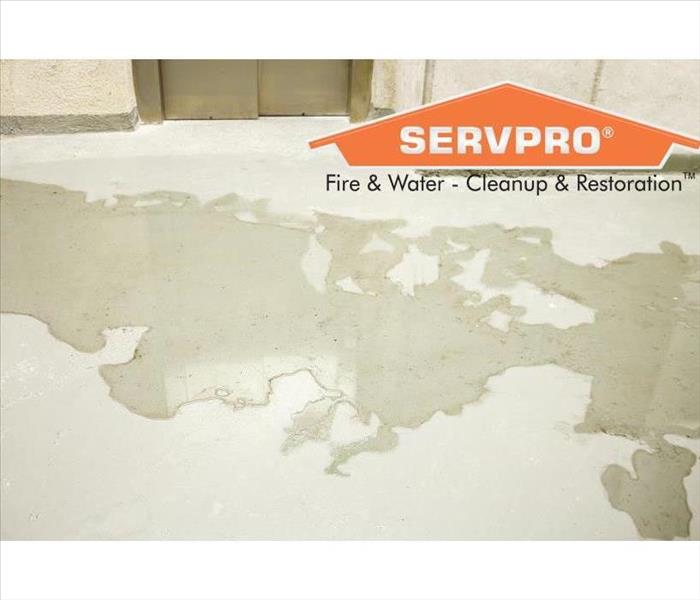 Sewage backup in Morrisville, PA
Sewage backup in Morrisville, PA
Why A Sewage Backup Might Occur In Your Home
A flooded basement is always a hassle to deal with, regardless of the cause. Cleaning and sanitizing becomes more important than ever when the flood is caused by a sewage backup. Here is some helpful information about why a sewage backup might occur in your home in Morrisville, PA, and how to deal with the aftermath.
1. Why Sewage Backups Happen
When water comes up through sinks and drains in your basement during and after a storm, this indicates a problem with water backing up from the municipal sewer system. Heavy rains overwhelm the combined sewage lines and push water back through the system and up into the home. This can be exacerbated by lines that may already be clogged by things like tree roots, grease, or excess waste.
2. Cleaning Is Vital
The first step after any flood is to extract the water. In the case of a sewage backup, this can be a gross and messy endeavor. Special water pumps and vacuums used by professional storm damage restoration services could be valuable tools in this process. Once everything is throughly dried, including the floors and walls that may have been affected, focus on cleaning and sanitizing everything. A sewage backup in a flooded basement may contain fecal waste, causing a serious health hazard. Sanitize whatever can be cleaned, then discard and replace the rest.
3. Be Proactive
As it's a problem caused by community sewage lines, it's impossible to entirely prevent backups from happening, but there are things you can do to lessen the odds. Install a backflow preventer that stops sewer water from entering the house. Practice regular maintenance of your individual lines and pour a tree root killer down your toilets once a year. The installation of a sump pump may also help in some homes.
Sewage backups from storms are impossible to predict. Do not store valuables where they might be destroyed without warning by a flooded basement.
Inspect Your Building’s Exterior for Post-Storm Damage
9/2/2020 (Permalink)
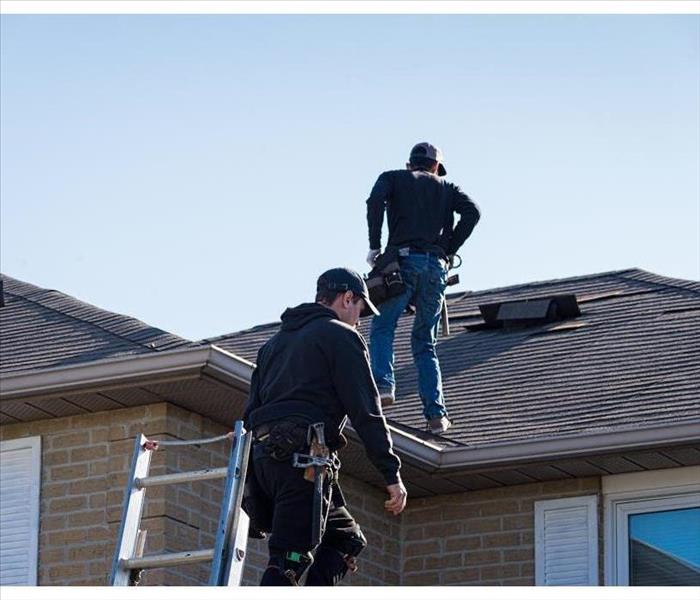 It's important to inspect the roof of your building
It's important to inspect the roof of your building
Check The Following Parts Of Your Building
Your commercial property is likely to sustain storm damage at some point. Mitigation should begin as soon as possible. Regularly performing exterior maintenance helps to prevent severe issues from occurring. However, sometimes they’re unavoidable. Therefore, you should complete a thorough building inspection after a storm. Be sure to check the following parts of your building.
1. Roof
It probably comes as no surprise that the roof is typically the most vulnerable part of your building during a storm. Has it been affected by a fallen tree, high winds or hail? It’s probably suffered a combination of at least two of these. Any of these factors can result in missing shingles, or worse, holes in the roof.
2. Windows
Windows can break or crack. They might also sustain paint loss or dents. Additionally, the screens can dent or crack along the frame and the screen material can tear or get holes in it.
3. Doors
Doors can also be susceptible to damage. This damage can include dents, stripped paint or damage to the frame’s trim.
4. Exterior Walls
Different types of building exteriors are susceptible to varying types of damage. Wood might crack and its paint might also strip off. After a severe storm, replacing some areas might be necessary. Metal siding can dent or crease. Vinyl siding might crack. Sections of siding can blow off in extreme winds. Stucco can be dented, chipped or cracked. Replacement of some of the stucco coat may be necessary if the cracks are bad enough.
5. Gutters and Downspouts
Heavy winds or storms can damage the outside and inside of gutters. Metal gutters and downspouts might dent, while PVC will sometimes crack.
There aren’t many structures that are immune to every type of storm damage. Keeping your building maintained, before and after a storm, will pay off. If your Woodside, PA, building requires post-storm interior or exterior maintenance, you can count on storm damage cleanup professionals. They’ll return your property to its preloss condition as quickly as possible.
A 5-Point Storm Preparedness Checklist
8/14/2020 (Permalink)
Prepare for Common Risks
Storms cannot be prevented, but building owners and managers can prepare for common risks. These five exterior maintenance measures will reduce the potential for storm damage to a structure in Newtown, PA.
1. Building Exterior and Envelope
A property owner or manager can only consider a building maintained if the envelope is in good condition. This layer of a structure is designed to prevent water from permeating walls. A building inspection should account for the envelope in addition to roofing materials, exterior doors and windows.
2. Windows
Depending on when the next storm is anticipated, a building owner or manager can take several measures to avoid window damage. Storm shutters may be the right choice for structures in areas prone to high winds. If a storm is rapidly approaching, an owner or manager can board up or tape an "X" shape in the middle of each window to try to stop glass from shattering.
3. Drainage
Roof drains, gutters and downspouts direct rain off of the roof and away from the foundation of a building. Exterior maintenance is necessary for this system to function.
4. Landscaping
Tree care should take place throughout the year. Pruning dead or loose branches and cutting back overhanging limbs can prevent major storm damage. The grounds can also be modified with grading and rain gardens.
5. Outdoor Items
Items kept outdoors should be stowed or secured when hail or high winds are on the forecast. Be sure to account for antennas and other equipment on the roof as well as seating, trash cans and other features on the ground.
These exterior maintenance measures can make any building more impervious to moisture and wind damage. It is important to plan ahead, as preventative options become limited before a major storm in Newtown, PA. A property owner or manager should arrange for commercial mitigation and restoration if adverse weather results in damage.
The Truth About Sewer Line Backups and Insurance Coverage
8/13/2020 (Permalink)
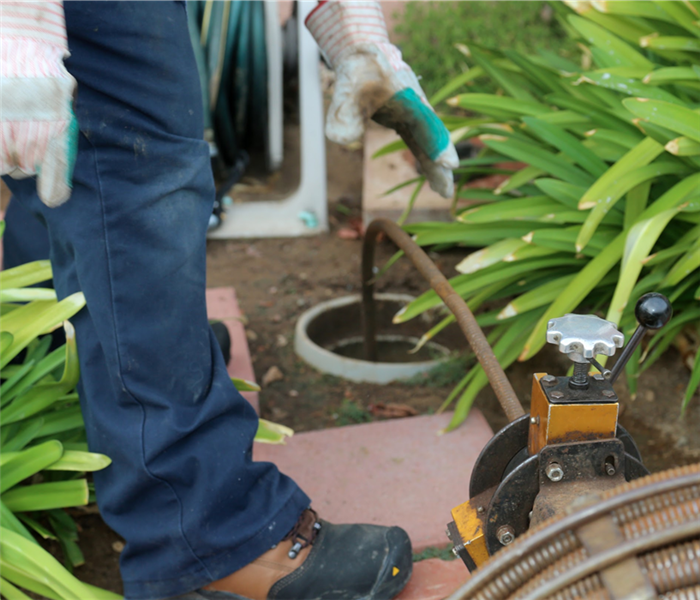 Sewer line cleanup in Lumberville, PA
Sewer line cleanup in Lumberville, PA
If you experience water damage in your home, you'll quickly turn to your insurance company for help. Homeowner's coverage in Lumberville, PA, will pay to clean up the water and the problems it causes. This includes replacing building materials and belongings and restoring your home. However, not all types of flooding are covered under a normal policy. A sewer backup would be your responsibility unless you supplement your insurance.
How Sewer Lines Develop Problems
If you smell a foul odor in your basement or see wastewater coming up through the floors or drains, you'll know there is a sewer backup issue. The line that runs between the city's mainline under the street and your home can become damaged, causing flooding in your house. This can occur because of the following causes:
- Blockage from tree and shrub roots
- Ground movement in the area
- Wear and tear as well as lack of maintenance and upkeep
Paying for Cleanup
Many homeowners don't realize that home insurance does not cover sewer line breaks and resulting flooding. This is your responsibility. The bad news is that cleanup costs from a professional sewage restoration company can be extensive, surpassing $20,000 or even $30,000 in some cases. Such incidents can also occur at any time without warning.
Getting Help
If you are concerned about the possibility of a sewer line break causing a flood in your house, you can get supplemental insurance coverage. There are plans available to cover sewer flooding and damage. Make sure you speak to your agent if you are interested. This plan could be useful for something as seemingly minor as a backed-up toilet to a devastated sewer line that sends raw sewage into your basement.
If the thought of a sewer backup scares you, talk to your insurance agent today about purchasing additional coverage. You can then have peace of mind to know that someone has your back.
Do Homeowners Need Sewer Backup Coverage?
5/1/2020 (Permalink)
 Do you have sewer-backup coverage?
Do you have sewer-backup coverage?
Three Reasons to Seek Additional Coverage For a Residence
A sewer backup is a messy and smelly problem that can pose risks to personal health and structural integrity. While homeowners insurance covers some sewer issues as part of a structure, damage caused by backups is often excluded from these policies. Here are three reasons to seek additional coverage for a residence in Plumstead Township, PA.
1. Most Policies Exclude Backups
The majority of homeowners insurance policies exclude sewer backups. The only way to avoid paying the entirety of cleanup and restoration costs for the resulting damage is to get an endorsement or rider for backup coverage. This policy provides coverage for a variety of damage that is cut out of most general policies.
2. Cleanup and Restoration Costs
A sewer backup can range in severity from a clogged toilet to outside flooding that causes sanitary sewer mains to back up into a basement. Any damage involving contaminated water and solid waste requires disinfection. The cost of cleaning, tearing out damaged building materials and restoring the affected area can be considerable. Water damage restoration specialists can provide all of these services and may limit the extent of the damage.
3. Reduce Expenditures Up To Sewer Line Repair
Coverage for backups is an important addition to home insurance coverage. This policy only applies to damage to the structure or interior of a residence. Sewer line insurance can cover line issues and reduce the out-of-pocket costs of accessing the pipe, locating blockages or identifying a collapsed sewer line and repairing or replacing any portions of the pipe.
Sewer backup coverage can be helpful for managing the costs associated with cleaning up contaminated water and waste. An endorsement for backups does not extend to the cost of sewer line maintenance or replacement at a property in Plumstead Township, PA. Maintaining additional coverage for backups or sewer lines can minimize out-of-pocket expenses for a variety of problems.
Preventing Flood Damage to Commercial Properties
4/10/2020 (Permalink)
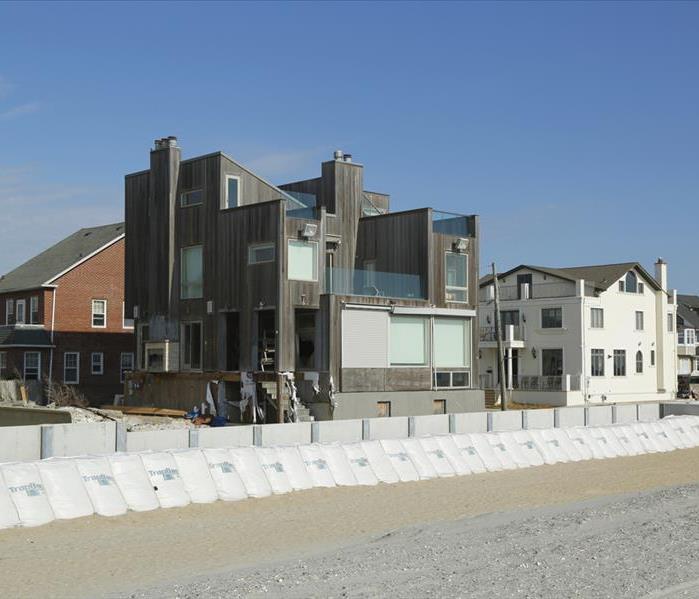 Build barriers around the premises of your building in Plumsteadville, PA
Build barriers around the premises of your building in Plumsteadville, PA
Preventing Flood Damage to Commercial Properties
Global warming doesn’t just affect the temperature of the planet. It is also causing sea levels to rise, increasing the risk of major flooding. Even areas that are not prone to extensive flood damage have had to deal with this issue in recent years.
If your building survives the disaster, the cost of flood cleanup is immense. From 2010 to 2014, an average commercial flood insurance claim cost approximately $89,000. It is perhaps no surprise then that at least 25 percent of companies that shutter due to a flood ultimately close down for good.
A high tide alone can cause severe destruction to your Plumsteadville, PA, building. Still, the most harmful floods usually accompany a heavy rainstorm or hurricane. That is why you should take steps to limit this type of storm damage. There are several ways you can do this:
- Move to a higher elevation
- Build levels or barriers around the premises
- Flood-proof your building
Of course, it is hard to move an established property to higher ground. Exterior barriers alone may not be sufficient, either. That is why creating a water-tight building is the best way to prevent flood damage.
What To Consider
Before you enact any flood-proofing plan, you should perform a benefit-cost analysis to make sure your project is cost-effective. You should also ensure that the workers will have safe access to and from the building once the flood-proofing measures are enacted.
How To Plan
You should also decide how your employees will enact the flood-proofing measures once the storm arrives. Assign various tasks to different workers and practice your plan ahead of time. You should also regularly inspect the flood-proofing system and fix any problems immediately.
Flood damage has affected more and more buildings in recent years. By preparing in advance, you can limit the destruction to your property. If your premises is affected by a major weather event, storm cleanup and restoration experts can assist with the recovery.
3 Things Every Homeowner Should Know About Flood Plains
11/15/2019 (Permalink)
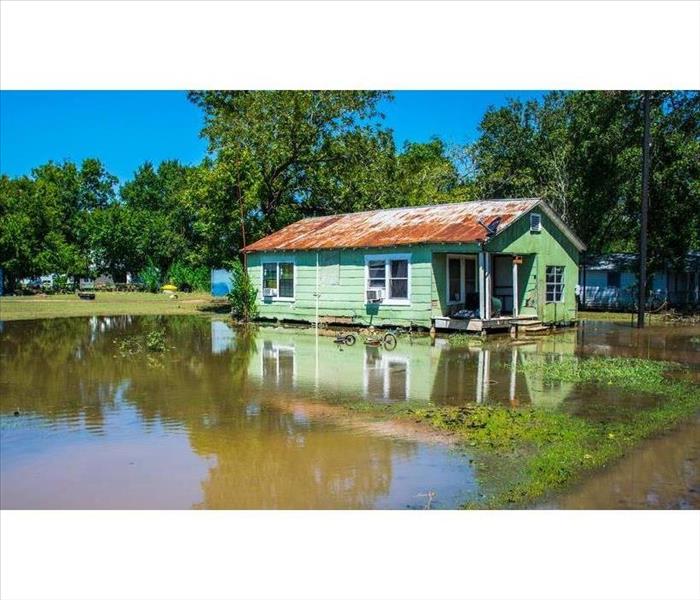 It's often wise for you as a homeowner to know whether or not your home is in a flood zone
It's often wise for you as a homeowner to know whether or not your home is in a flood zone
3 Things Every Homeowner Should Know About Flood Plains
Do you know if your home in Point Pleasant,PA, is at risk of flood damage? Though no one wants to think their house will be affected by a flood, a house in a flood zone is significantly more susceptible to water damage. There are several questions every homeowner should know the answer to when it comes to flood plains in their area.
1. What Is a Flood Plain?
Areas that are depressed in the landscape and close to rivers are considered flood plains. As the name suggests, these areas are particularly prone to flooding. Though a flood plain is lower than average areas in a landscape, under normal conditions, a flood plain may not be apparent. For this reason, it's often important to verify whether or not your home is on, or close to, a flood plain.
2. How Do You Know if Your Home Is on a Flood Plain?
Many homeowners don't know how to check where flood plains are in their area. However, FEMA (the Federal Emergency Management Agency) has an easily accessible Flood Insurance Rate Map (FIRM) that provides information about what areas in your locality are in a flood zone. The FIRM also notes which areas may be hazardous during a flood.
3. What Can You Do To Protect Your Home on a Flood Plain?
Just because your home is on a flood plain doesn't mean you can't take steps to protect your home from a storm. If your home is on a flood plain, it can be useful to use your landscape to your advantage by planting a rain garden. You may also consider elevating appliances in your home to minimize the risk of damage if a flood does occur. It can also be useful to research flood damage mitigation and restoration experts before a disaster.
It's often wise for you as a homeowner to know whether or not your home is in a flood zone. By learning about and locating local flood plains, you can better prepare for the effects of a flood.
Preparing Your Company for a Disaster
10/28/2019 (Permalink)
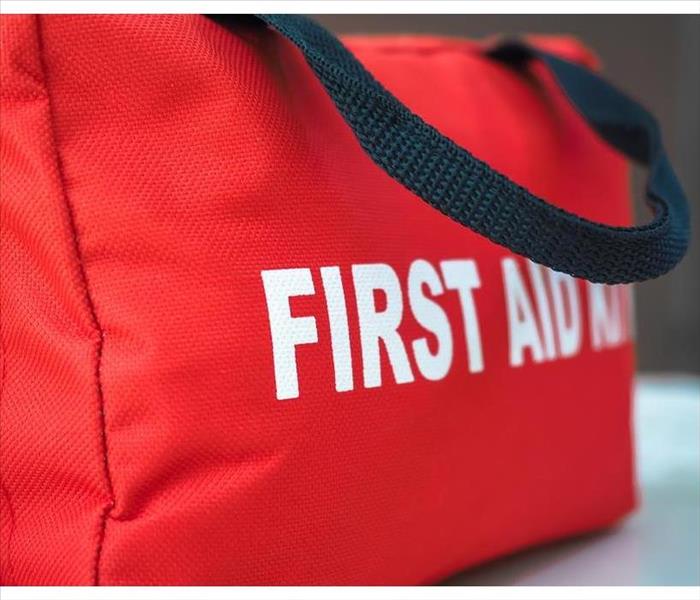 By installing emergency stations with flashlights, first aid kits, food and water, you will help ensure the safety of everyone on site
By installing emergency stations with flashlights, first aid kits, food and water, you will help ensure the safety of everyone on site
Disaster Preparedness
Fires, floods, tornadoes and terrorist attacks can happen with little to no warning, but you can minimize damage to your business with disaster preparedness. Proper planning can protect your business from rising floodwaters and reduce the risk of fires. A well thought out plan will help get your business back in operation as quickly as possible, reducing the impact on your customers, employees and bottom line. By working with a restoration company, you can quickly repair any physical damage that has occurred to your building. Here are four tips on preparing your business for a disaster.
1. Stockpile Emergency Supplies
If an unexpected event happens, you and your employees need to be prepared to face the situation until help arrives. By installing emergency stations with sanitation wipes, flashlights, first aid kits, food and water, you will help ensure the safety of everyone on site. You may also consider asking employees to bring certain supplies from home to meet personal needs.
2. Evacuate or Shelter in Place
Advance planning on what to do makes all the difference in disaster preparedness. Better decisions are made ahead of time. You can decide under which circumstances you will evacuate and under which situations you will stay. You must have detailed strategies on how to safely adhere to each plan.
3. Ensure Fire Safety
Fires are the most common disaster facing organizations. Business preparedness helps minimize your risk of fire by ensuring smoke detectors, fire extinguishers and fire sprinklers are in working order. Be sure to adhere to regular maintenance inspections.
4. Communicate With Employees
Once you have a plan in place, be sure employees are aware of the procedures and any action items they are responsible for. Walkthrough drills are always a great option in preparing people for the unexpected.
Although you cannot eliminate the risk of a catastrophe, disaster preparedness can help to minimize your danger and reduce the impact. If a calamity strikes in Solebury,PA, rest assured that an expert restoration company can help restore your business to its previous condition.
What To Know About Winter Storm Damage
9/30/2019 (Permalink)
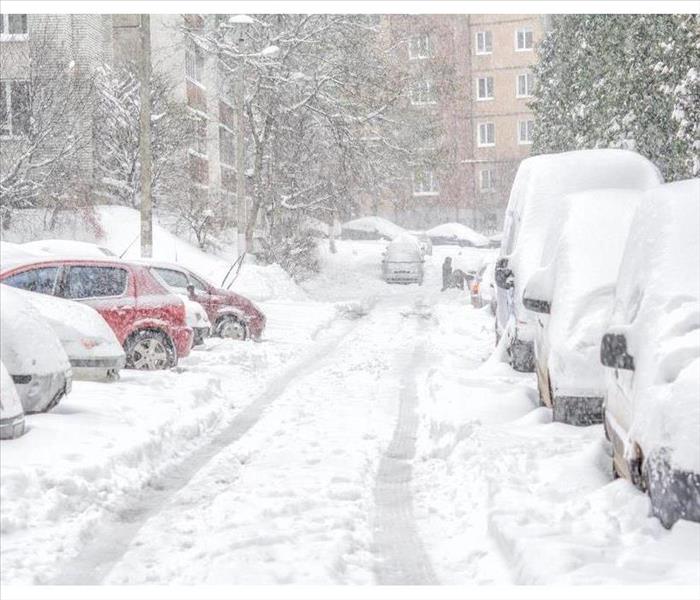 Winter storm in Yardley, PA
Winter storm in Yardley, PA
What To Know About Winter Storm Damage
In Yardley,PA, winter storm damage can lead to a number of unexpected problems. From damage type, to cleanup methods, here are a few things you may want to know.
1. There Are a Few Ways To Mitigate Damage
Before the blizzard, or similar winter weather arrives, there are several mitigation steps you can take to protect your home. Check and unclog any gutters around your home to prevent water backup and possible flooding. You may also want to check for any loose shingles or siding that can be torn off by the wind, and trim any branches that may be able to fall into your home. It's also a good idea to insulate any exposed pipes that are in danger of freezing.
2. Cold Weather Can Lead to Several Types of Damage
The winds and weather that comes with a winter storm can cause several types of damage to your home. Chill temperatures can freeze pipes causing them to break and potentially flood once any water in them thaws. High winds can pick up to debris and other loose items and throw them into the home causing damage. Wind can also cause damage to the roof which may then leak once thawing occurs.
3. Damage Area of Your Home Can Be Restored
It's important to note that even if winter weather does lead to damage to your home, it can be restored. A local storm damage restoration service is trained to deal with a number of damage types including roof damage, flooding, mold problems, and other repairs. With a little time and effort they can have your home looking as if nothing ever occurred.
Whether a winter storm has led to a damaged roof, or frozen pipes, your local restoration service can you get your home back in working order. They can also help recommend ways you can mitigate damage in the future.
How to Protect Your Building From Flood and Storm Damage
8/22/2019 (Permalink)
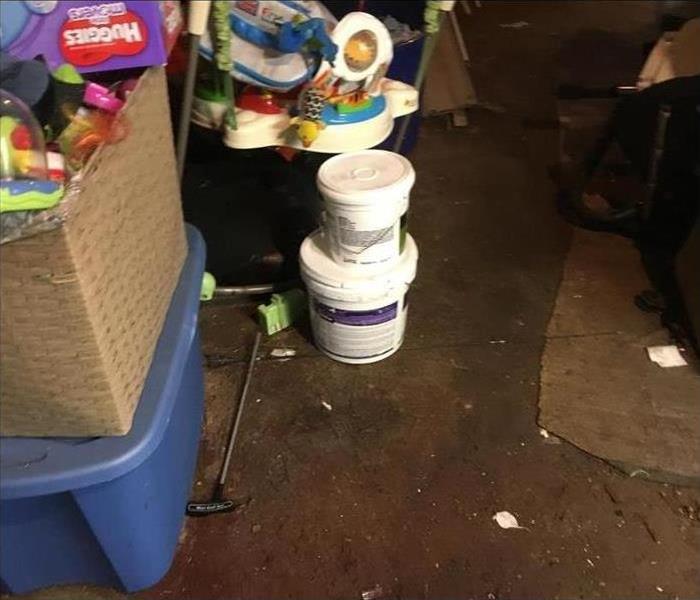 Storm damaged home in Woodside, PA
Storm damaged home in Woodside, PA
How to Prepare Your Building From Catastrophe
Warmer weather often brings about heavy storms. These can wreak havoc on your commercial building in Woodside, PA, if it's not properly protected from flood damage. Many people don't realize that there are different ways to prepare their building though. Here are a few things you can do to help prepare for catastrophe.
Flooding
Heavy rainfall can seep in through small openings in your building and cause mild to severe flooding. One of the best ways to avoid this is to have the space inspected before storm season begins. Make sure all windows are sealed properly. It is especially important to have your roof looked at ahead of time and get all cracks repaired. You should also have your gutters thoroughly cleaned out before storm season. During a storm, leaves and debris can buildup and lead to further issues.
Storm Damage
One of the main causes of serious storm damage is from trees falling and hitting the building. While this is not fully preventable, you can have some of the larger or over-grown branches trimmed or cut off. It is also crucial to have a safety plan in place. Be sure to train your employees on what to do are where to go in the event that a storm does hit.
Restoration
Even if you talk all precautions, sometimes flood damage still happens. In this case, you should call a professional restoration company right away. Standing water in your building can lead to mold growth and should not be left there for any longer than it has to. These professionals can also help repair damage to the building caused by the storm.
Preparing your building for flood damage ahead of time is one of the best things you can do, but it is also important to have a plan in place for if disaster does strike. Taking care of the restoration process right away can get you back in business before you know it.
Winterize Your Home To Prevent Damage
7/10/2019 (Permalink)
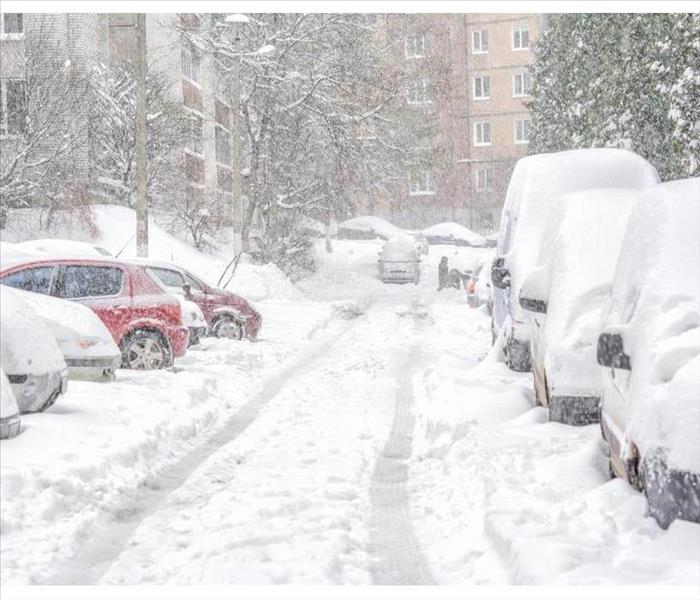 Winter is tough on everybody in Point Pleasant,PA, including your home.
Winter is tough on everybody in Point Pleasant,PA, including your home.
How to Protect Your Home from Winter
Winter is tough on everybody in Point Pleasant,PA, including your home. If it's not fortified for the ice and snow coming your way, you could take on some damage- especially in the case of a winter storm. Do what you can to protect that which gives you shelter.
Get It Inspected
Certain aspects of your home are more vulnerable than others to the effects of a blizzard. Get an inspector to take a look to make sure they are as prepared as possible. If you do experience damage, make sure to research a storm remediation company that you trust to make repairs afterward. Some common areas to keep an eye on are your:
- roof
- insulated pipes
- insulation
- window seals
Store Emergency Supplies
You are bound to get stuck indoors during a winter storm at some point during the bleak months of cold. You will be a lot more comfortable if you have everything you need with you already. The following items can be especially important if you lose power or your pipes freeze: snow shovels, crank radio, jugs of water, non-perishable food and blankets. A backup generator and extra fuel can be helpful for keeping your refrigerator or heater running.
Don't Forget Your Yard
In order to avoid roof damage you can trim back tree branches that are near any structures or windows. You should clear your gutters as best you can before the first freeze. If you know a storm is coming, bring in any extraneous objects that you can, like lawn furniture, garbage cans and decorations- this will also make it easier when it comes time to shovel.
Getting your house through a winter storm may require some additional work on your part, but it will be well worth it. You'll have a much happier winter if you can manage keep your home warm and damage-free. All that's left is to dream about the approaching spring!
3 Types of Odors That May Exist After a Home Flood
4/25/2019 (Permalink)
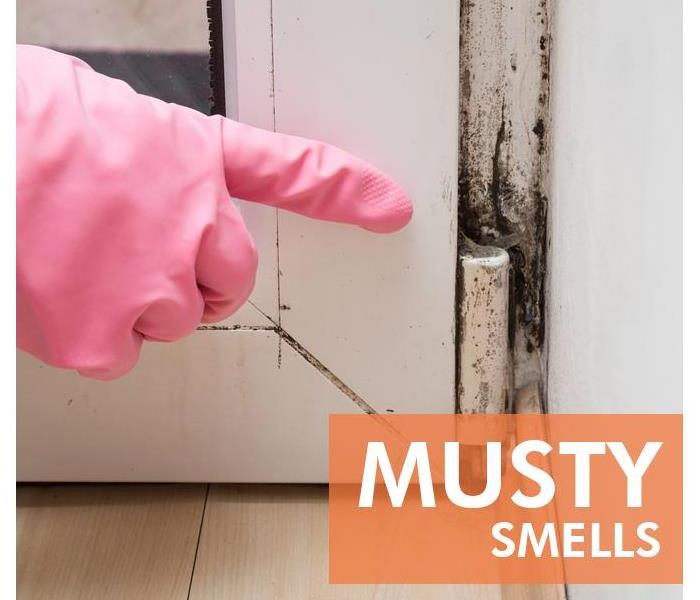 Mold can cause a musty foul odor due to the mycotoxins it can release.
Mold can cause a musty foul odor due to the mycotoxins it can release.
After a flood at your Woodside, PA, home, you may be facing a variety of problems. However, one that you may not expect is the odors flooding can create. Mold growth, sewer water, and debris can all leave foul smells behind, even after the water is drained away. If you have recently experienced a flood in your home, there are a few ways to sniff out the source of these smells so you can have them eliminated.
1. Musty Smells
After floodwater enters your home, it may be absorbed by drywall and other porous building materials. This can cause mold to grow in the interior walls, especially if they contain insulation. Mold can cause a musty, foul odor due to the mycotoxins it can release. In most cases, the stronger the musty smell, the more serious the mold growth invasion.
2. Dirt or Earthy Odors
When outdoor flooding invades your home, it can also bring mud, clay and other types of dirt along with it. Earthy or wormy odors can be left behind in your walls or under carpeting, where they can linger for weeks afterward. Having porous building materials replaced can alleviate this issue. Consider having drywall and molding torn out and the rooms professionally cleaned before any reconstruction takes place.
3. Sewer Smells
Few odors are as unpleasant as those that come from a sewer. If your home experienced a flood due to a sewage loss, the bitter, foul smell could remain long after the water is drained away. Calling in a storm damage and flood restoration service may give you a number of options for removing this smell, from the use of ozone machines to special cleaning techniques that typically cannot be found elsewhere.
Mold growth, dirt and foul sewer smells can make your Woodside,PA, residence smell unbearable after a flood. Learning where these smells come from and how to eliminate them can restore your happy home.
5 Tips for Maintaining Your Roof
2/12/2019 (Permalink)
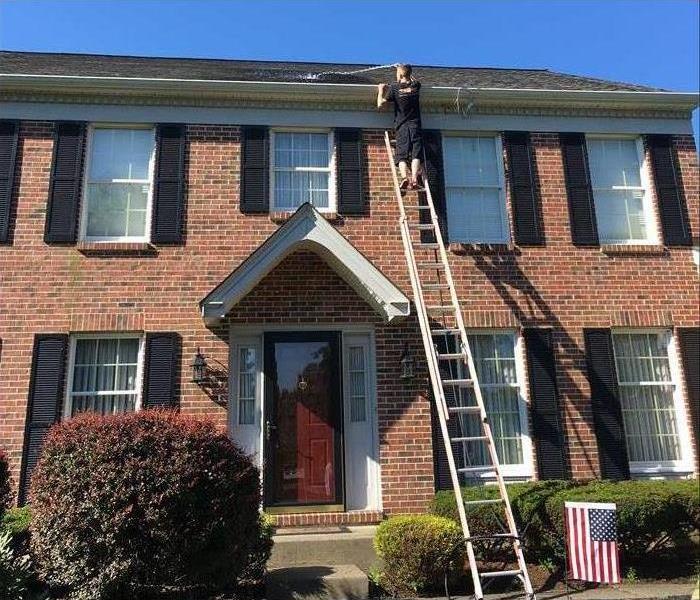 Gutter cleaning in Yardley, PA, home.
Gutter cleaning in Yardley, PA, home.
How To Maintain Your Roof?
If you own a business in Yardley,PA, you may be worried about roof damage to your commercial property. Fortunately, there are a number of things you can do to help keep the roof of your business in working order.
1. Keeping Gutters Clean
One important step for roof maintenance is to keep your gutters clean. This can help prevent blockages that can lead to flooding and pooling water on your roof. It's best to check your gutters after storms to ensure that no debris has been washed into them.
2. Monitor the Roof’s Condition
It's also important to monitor the roof's condition on a regular basis. Look for any wind damage, loose shingles or cracked tiles. These are all things that should be taken care of as quickly as possible.
3. Regular Inspections
A regular inspection by a professional can help prevent roof damage in the long-term. These professionals can look over your roof for any signs of damage you may have missed. If found, repairs can be conducted to get the roof back into working order.
4. Trim Back Trees
Another step you can take for roof maintenance is to trim back any tree branches that could fall onto the roof. This can help prevent damage in the event a storm causes brakes in the tree limbs.
5. Conducting Repairs Quickly
In the event you do find damages or areas needing repair on your businesses roof, then a professional restoration team may be able to help. In the event of extreme damage, they may even be able to perform a full roof rebuild.
Following these steps can help reduce the possibility of roof damage to your business. Remember to keep your gutters clean to prevent flooding, inspect for cracks in shingles or roof tiles, trim back any tree branches that could fall into your business, and conduct any repairs needed as quickly as possible. If you do find the roof has storm damage, then a professional may be able to help.
Newton, PA flooded Homes
11/20/2018 (Permalink)
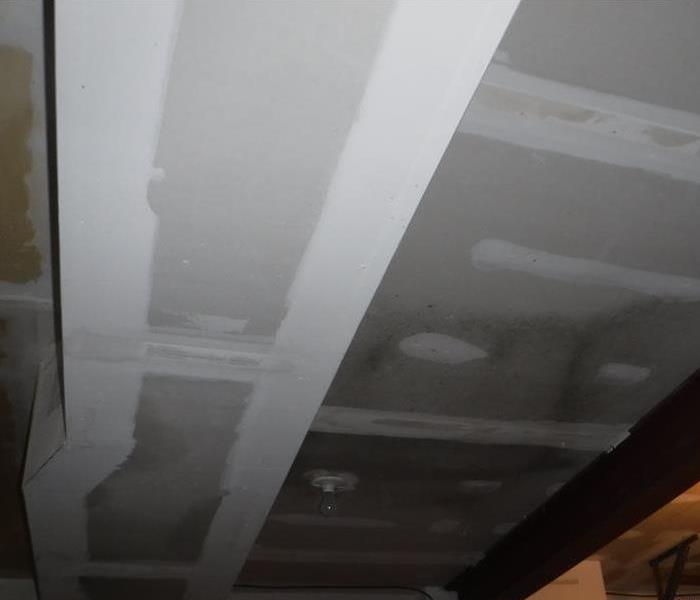 Ceiling Water Damage
Ceiling Water Damage
Flooding During Storm
Storms can cause a lot of problems for homeowners. Rain water tends to find its way into basements and crawlspaces of homes in the Newtown area.
When flood water enters a basement it is usually through a window or basement entrance. Both have drainage but during a storm the drains can be clogged or filled. The malfunction allows the water to get into the home causing damage to the carpet, drywall, and contents.
When water enters a crawlspace it does damage to the subfloors and electrical or HVAC system. Crawlspaces are notorious for growing mold after a water intrusion.
At SERVPRO of Newton/ Yardley, we make sure to clean your home after flooding. Call us 24/7 for emergency mitigation and restoration services at (215) 579-4423.
Being Safe Around Water Removal and Electronics
9/27/2018 (Permalink)
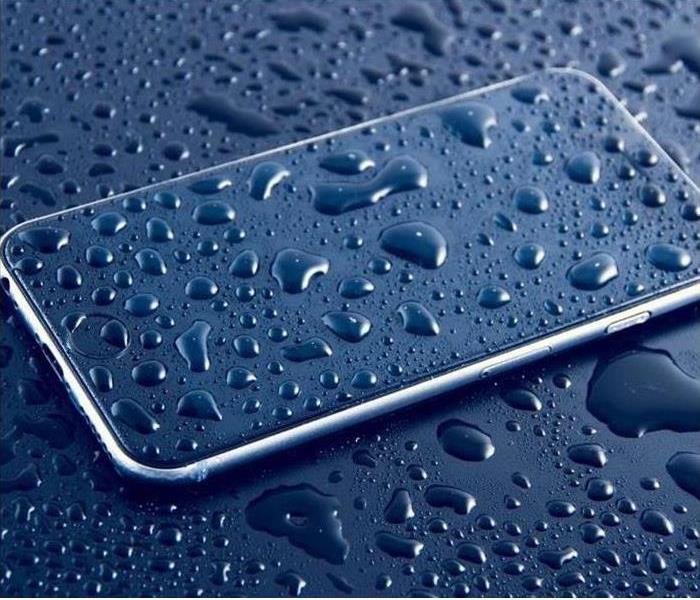 When electronics meet water damage, usually only bad things come to mind. That's until you learn SERVPRO is professionally equipped to deal with this.
When electronics meet water damage, usually only bad things come to mind. That's until you learn SERVPRO is professionally equipped to deal with this.
When dealing with flood damage (or any heavy water damage, for that matter), extreme caution must be taken when dealing with the risk of electrocution and shock. Water is highly conductive to electricity, and high waters can claim lives if you're not prepared for the risks that may lie within. Never attempt to use an electrical outlet following water damage in that area, never wade or walk into floodwaters, and try to stay away from wet areas in general until we can assure you that there is no electrical hazard.
Wall Outlets
One of the primary reasons why fast water removal in Bristol is necessary in the event of a flood is to reduce the risk of electrocution via wall outlets and plugs. When submerged in water, these can deliver extremely high voltages of electricity, enough to seriously injure or kill in addition to causing serious burns. Wall outlets present a major hazard, particularly in businesses with employees, and in the event of flooding not even a plastic safety cap can ensure safety in deep waters. Always wait for our SERVPRO technicians to remove and dry off all water from a room before entering it in order to avoid electrocution.
Electronic Devices and Appliances
Some electronic devices, appliances, and furniture pieces may also present significant hazards even when an area is not flooded. If sufficiently soaked, everything from lounge chairs to televisions to kitchen appliances can present a life-threatening hazard. Items such as speakers or computer consoles which lie on the flood can also present serious dangers even after water has been pumped, as they may have a loose electrical cable or circuit which connects to wetness in carpet or on flooring.
Locally Owned Company with National Resources
At SERVPRO of Levittown Newtown Yardley, we make sure to equip our technicians with the latest and best in safety gear in order to keep both them and your business safe from electronics when dealing with water damage. Call us 24/7 for emergency mitigation and restoration services at (215) 785-1777.
6 Ways FEMA May Help After a Storm
9/17/2018 (Permalink)
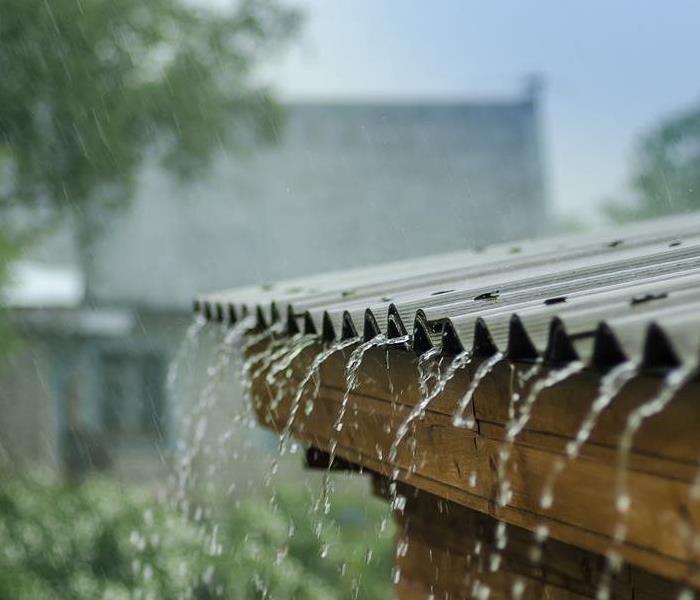 Storm Damage can be aided by FEMA and other professional restoration companies
Storm Damage can be aided by FEMA and other professional restoration companies
After flood damage in Newton, PA, you immediately call your insurance company and begin a claim. There are so many needs you have right now, so what can you do about those things your insurance won’t cover? What if you don’t have insurance? Here are 6 ways FEMA may be able to help you after a disaster:
1. Housing. This may include temporary funds for rent while your house is being repaired or while you get ready to move to other, permanent housing. Direct housing may also be provided temporarily, especially if there are no available rental options in the disaster area.
2. Transportation. Replacement of a vehicle damaged in a storm or flood may be included in the government assistance program.
3. Childcare Costs. Sometimes childcare is needed as the result of a disaster, and this may be financially provided to you.
4. Medical Costs. Medication, as well as dental and medical services, may also be covered if the need is due to a federally declared disaster.
5. Storage or Moving. The cost of moving and storing your belongings until repairs are finished on your home may be covered by FEMA.
6. Personal Items. Any personal belongings that are needed and not covered under insurance, including mobility aids, appliances, and furniture, may also be part of the federal aid.
Many people don’t have flood insurance, so there is a lot of need for additional financial help after a disaster. If you do have insurance, be sure to file with your insurance company first. When registering for disaster assistance, you are required to share the insurance information with the government because it cannot provide financial assistance for anything that is already covered by your insurance.
Storm damages aided by FEMA must be from a federally declared disaster area. So much cleanup is needed to restore your property from flooding, but there are professional restoration companies that can take care of your needs and even help facilitate the insurance process for you.
For more on Newton click here.
Important Mitigation Steps To Avoid Mold After a Flood
9/4/2018 (Permalink)
 Home flood in Yardley, PA
Home flood in Yardley, PA
Storm waters may put your commercial building in Yardley, PA, at a higher risk of developing mold growth. This type of flooding usually comes from overrunning rivers, sewage backups and other unclean sources. This means the water could contain bacteria, spores and other contaminants that increase the chances of fungus growth. Your commercial storm remediation team can help you mitigate the damage done to your building to stop mold from setting up a colony on your property.
1. Remove Standing Water
Quickly draining any standing water from your space can help reduce the chances of mold spores finding a home. Water left for 24 to 48 hours will likely introduce mold spores to your property even if the flood started from a clean source. The sooner you start to drain the flood the better.
2. Start Drying Out the Space
Once the flood has been drained, you need to start sucking out excess moisture too. Getting a handle on high humidity levels can make the restoration process easier. You won't want to start making repairs until the building is completely dry. If you aren't able to properly dry out your rooms, you may end up with mold growth sometime in the future. Mold doesn't need floods to grow. It simply requires excess moisture in the air.
3. Add Protection
If your standing water was caused by a hole in the roof or a flooded basement, you need to try to stop this flood from happening again. Cover up any holes in your building to stop the weather elements from negatively affecting your building. You can use tarps and boards on the roof and walls to help you achieve this goal. Install a sump pump to keep water from building up in the lower levels of your property.
Starting the cleanup process soon after a flood can help you avoid the hassle of mold growth. Mitigation is a quick form of cleaning that addresses major problems, though restoration may be needed to help get your building back to its pre-flood status.
Key Facets of Business Interruption Insurance
6/15/2018 (Permalink)

As a business leader, you have tremendous responsibility to lead your organization. This not only includes building strong relationships with customers and ensuring they’re satisfied with your service, but it also requires a talented staff to produce the results you need. You strive for profitability and growth, but what happens if a natural disaster or other major incident causes a rebuild of your facilities? Fortunately, business interruption insurance can come to your rescue.
How Does It Work?
Unlike property insurance, which can cover your expenses to make repairs to your facility due to an accident or mishap, this type of coverage can help ensure you don’t lose money when you have a closed business because of unsafe conditions at work or it’s impossible to carry on your business affairs for a time for any reason. There are a few ways that this insurance works for you:
• Compensates you for income you lose because you must leave your facility
• Covers you for revenue you would have earned had the disaster not occurred at your Newtown, PA office
• Pays for other expenses such as utilities while you are out of the office
Flexible To Meet Your Needs
Business interruption insurance can be essential for your company while you rebuild your office space. It’s important to make sure you work closely with your insurance company and select the coverage you need. You don’t want to choose too little and miss out on the necessary compensation. Luckily, the best agencies should be able to fit your organization with an ideal plan.
Coverage Costs
Some businesses have greater risk of problems than others due to fires or other disasters. If you work in a field that is more prone to incidents such as these, you may expect higher premiums. Also, if you cannot reasonably conduct business outside of your facility, you may have higher costs.
You should discuss this type of insurance coverage with a seasoned professional. You can have greater peace of mind during a rebuild with this plan in place at your business. Visit http://www.SERVPROnewtownyardleypa.com for more information on storm damage.
How To Mitigate Roof Damage Before Help Can Arrive
4/23/2018 (Permalink)
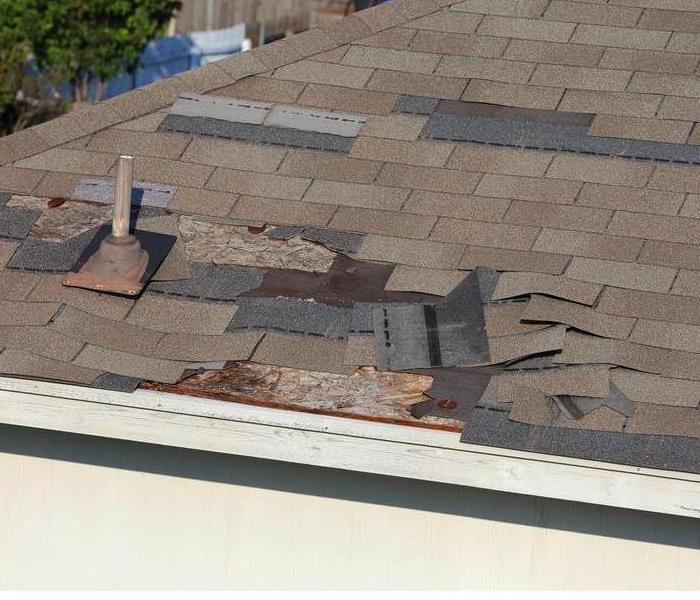 Give SERVPRO a call if you experience storm damage in your home or business.
Give SERVPRO a call if you experience storm damage in your home or business.
Heavy winds, torrential rains, excessive snowfall or large hail can all result in significant roof damage. Unfortunately, even if you call a Newtown, PA storm damage repair team the day after the damage occurs, it may be weeks or even months before a complete repair can be done. This may be because other homeowners in the area have been affected as well or because your insurance company is slow to process your claim. Whatever the reason, you need to take steps to mitigate damage in the meantime. There are several things you can do to prevent further damage:
• Tarp your roof
• Cover broken or cracked skylights and windows with plastic
• Tarp your siding (if necessary)
• Remove tree limbs and other debris
Tarp a Leak
If your roof sprouts a leak in the latest storm, tarp it until the professionals can fully patch and repair it. If it is still raining, you can minimize damage to the interior of your home by placing buckets beneath the leak. Though you cannot do anything to minimize roof and ceiling damage, you can protect your floors and furnishings.
Cover Broken Windows
Just like you did with roof damage, protect your home and your family from the elements by covering any cracked or broken windows and skylights with plastic. Doing so can also protect your home from loose shards of glass that fall in.
Tarp the Siding
Wind damage is often not limited to just the roof. If your siding is loose or missing, call in a Newtown, PA contractor to tarp off the side to prevent further damage to the interior until a full repair can be done.
Remove Debris
Finally, any debris that is allowed to sit on your roof poses a greater threat each passing day. If a tree or heavy branch fell on your home, contact your local contractor to remove it and tarp your roof until quality repairs can be made.
If your home sustained roof damage in the last storm, it is imperative to take remedial action right away. Use the advice above to protect your home until a quality contractor can make permanent repairs. Visit http://www.SERVPROnewtownyardleypa.com for more information on storm damage.
Storm Restoration Process: How to Handle Storm Damages in a Business or Home
10/31/2017 (Permalink)
Storm Restoration Process: How to Handle Storm Damages in a Business or Home
Nature can be quite unforgiving. When disasters such as storms, flooding, river flooding, hurricanes, hails storms and ice dams strike, the effects are not only felt at individual levels but by the community at large. While insurance help cover the financial aspect of storm damage, roof damage, hurricane damage, hail damage, wind damage or ice damage up to some extent, the huge part of the savings are dependent upon the choices of the property owner. As an expert home restoration company, the following are some of the tips on how to handle storm damages and make huge savings.
Hire a professional water restoration company immediately
The first and important step when it comes to the storm remediation process is to hire an expert water restoration company as soon as possible. Given a chance storm damages such as flooding, river flooding, flood water and run off ground water can escalate very fast causing insurmountable damages to properties. By calling professional storm restoration to a storm damaged property, storms victims are able to save their properties. However, with high number of storm restoration firms in the market today, caution and due diligence is called upon when choosing the best the most qualified home restoration services.
Assess the extent of damages caused
After hiring a professional water restoration firm like us, the second step is to assess and evaluate the damages of the wind damage, hurricane damage, roof leak, ice damage, ice damming, hail damage or frozen pipes depending on the type of storm peril. This process is particularly of value to any storm victim as it not only helps them accurately assess the costs of insurance compensations, but also helps them plan on the financial aspect of the storm remediation process.
Clean up
The cleaning up process is of great importance to the home restoration process. To reduce the extent of damages, this process needs to be carried out as soon as possible, however with the help of experts. Different storm damages need to be approached differently. For instance with flooding, river flooding, flood water, excessive ground water and hurricane damages, the excessive water needs to be drained using flood pumps. This said however, there is no one-size-fit-all flood pump and hence the importance of working with an expert storm restoration company. In addition to these expert helping choose the right flood pump for the job, they are also help with commercial drying agents and roof repairs that ensures no more flood water and ground water are on a property.
The second area that needs to be cleaned up is ice damages. Ice damages is a problem mistakenly confused to occur in cold areas, nothing could be further from the truth. Properties in most parts of the world are susceptible to freezing if no proper insulation measures are put in place. Frozen pipes are normally caused by ice damming from regular ice dams that lead to roof repair. This can also extend to cause roof damages when ice dams block the passage of melted ice water. Hiring expert water restoration companies to help with cleaning up these ice dams is ideal since these professionals have the tools and expertise in this area.
Repairs and reconstructions
This is the final stage in any home restoration process. Depending on the extent of the damages caused on a property, this process can take up to several weeks or months to complete. In most cases, this process involves door, windows and roof repairs or replacement in properties adversely affected by wind damage. When it comes to hail damage and hurricane damaged properties, home restoration experts may come in handy to help fix the roof leaks. In addition to this, these experts may also help fix the frozen pipes caused by ice damming by heating up the ice dams and properly insulating the pipes to prevent further freezing. In advanced cases of frozen pipes, storm remediation. experts may be required to redo the plumbing works. With this in mind, it is important when hiring storm restoration experts that storm victims consider a company that can offer comprehensive services from fixing roof damages, repairing roof leaks to reconstructing certain areas of a house and protect them from flooding.
Regardless of the fact that we have weather forecast, it is quite difficult to predict when a storm can occur. In a matter of minutes hail damage, flood water, river flooding, wind damage and ice damming can leave severe damages that no insurance compensation can match up to. While we cannot prevent this occurrence, we can help protect you from further damages by fixing the roof leaks, roof damage and draining the excess ground water using our flood pumps to help with the roof repair and hurricane damage. Thanks to our storm remediation. services, we guarantee normalcy in no due time.
Visit http://www.SERVPROnewtownyardleypa.com for more information on storm damage.
Which of These Professional Storm Damage Restoration Services Do You Need?
9/26/2017 (Permalink)
Which of These Professional Storm Damage Restoration Services Do You Need?
When a storm come through, it can leave devastation in its wake. If you find that your home or business has sustained storm damage during a storm, you need to bring in the professionals to help. They can start the process of getting your home or business back into shape.
Flooding
Whether you have river flooding or water from a hurricane, flood water does a lot of damage. You need to get the ground water out as soon as possible. A flood pump will start removing the flood water. One of the main problems with flooding is the moisture it leaves behind. That can lead to mold and mildew problems.
River flooding and ground water flooding can damage the structure and destroy personal items. Getting a flood pump in place quickly will make all the difference. It will reverse the flooding and start the process of drying out the structure. That is when water restoration can begin.
After the flood pump has removed the river flooding, it is time to get the flood water out of the personal items. The restoration team will salvage what it can. They often find items which the ground water has not destroyed, but they also find items completely destroyed.
Don't let the flood water stay. Get professionals in to set up a flood pump quickly so that you can start recovering from the river flooding and ground water damage. The faster you start the water restoration process, the sooner you can return to normal life.
Wind Damage
A lot of storm damage comes from wind. The wind blows and it can strip off shingles and bring down trees. In fact, wind damage is a common reason for storm restoration services.
With wind damage, the storm restoration process starts with securing any openings in the structure. Then, it is a matter of determining what the extent of the storm damage is. Often times, store restoration involves water restoration as well because the wind damage let rain into the structure.
The storm restoration team will start drying out the structure as part of the water restoration process. Part of storm restoration is salvaging as much of the damaged property as possible. It is integral for business and home restoration.
Roof Damage
During a storm, the roof can sustain quite a bit of damage. You can easily get a roof leak or two, especially when dealing with hail damage. A quick roof repair will help keep water and wind from getting into the attic.
How do you know you have roof damage? A roof leak is obvious. But hail damage is not as obvious. Dents and divots in the roof is a sign you need a roof repair as soon as possible. Some roof damage is easily spotted, like missing shingles and flashing. Some roof leak drip while others gush. All roof and hail damage need quick roof repair to ensure no further damage.
Don't let hail damage or roof damage cause further problems. Stop a roof leak with a good roof repair. That is essential for business and home restoration.
Hurricane Damage
Hurricanes can wipe a region completely off the map. If your home or business has sustained hurricane damage, you need to get a storm remediation team in as soon as possible. They can assess the hurricane damage and start the storm remediation.
They will cover holes in the structure to secure the premises. They will start drying out the structure and removing damaged items as part of the storm remediation. Hurricane damage can involve the entire structure, or only that part opened to flood waters. That is why it is critical to go with professionals for storm remediation.
If your home is damaged in a hurricane, call in the professionals in storm remediation.
Ice Damage
Ice damage comes in many forms. Frozen pipes can burst and leave a space flooded. An ice dam on the roof can cause water backup under shingles. In fact, ice damming can cause damage to overhangs, soffits, and fascia. Don't let ice damage from an ice dam lead to roof problems.
Frozen pipes usually occur in uninsulated spaces like the basement. With frozen pipes, they can burst due to pressure. And that can cause flooding. So ice damage can be more than ice damming, though an ice dam is quite common in winter. If you have ice damming or frozen pipes, call in the business and home restoration specialists. They can remove an ice dam and clean up the problems caused by the ice damming.
Call in the business and home restoration specialists for any of these problems. Visit http://www.SERVPROnewtownyardleypa.com for more information on storm damage.
Woodside Flood Damage
9/10/2017 (Permalink)
Flooding in Woodside, PA
Flooding affects homes and businesses in disastrous ways. Using the right Flood Mitigation specialist will help save money on insurance. Mitigation companies such as SERVPRO of Newtown/Yardley have IICRC certifications that are required by the insurance industry. In this article we'll look at different types of flooring.
- Wood Floors - Wood is a porous building material which will hold water. Because flood water is considered Black Water any porous flooring will need to be removed.
- Tile Floors - Tile is not porous and will not need to be removed. The grout may need to be changed if the seal is old. If the water did not penetrate the subfloor the tile can stay.
- Linoleum - Is not porous but doesn't keep as well as tile. If water has intruded under the linoleum then it will need to be removed. Otherwise it is fine after being disinfected.
- Concrete Floor is porous but can be disinfected. Most concrete floors are sealed or painted too which can withstand the water.
Why do sewers back up during a storm?
9/10/2017 (Permalink)
Why do sewers back up during a storm?
There are several reasons why a sewer may back up during heavy rains in Yardley, PA. Homes in the area have been around for many years and their sewage systems are just as old. When it rains heavily some storm damage can occur in the form of sewer backing up into your home.
- Blockage is one problem associated with sewer backups. Blockages can be because of a broken pipe due to tree roots, construction debris, and objects being flushed down the drain.
- Broken backwater valves can cause a problem too. Most homes have an installed valve but they get old and need to be maintained. Without the valve sewer water will enter the home through the toilet and drains.
Have your home cleaned by SERVPRO of Newtown/Yardley if it suffers from black water intrusion during heavy rains.
Ice Dams in Morrisville, PA
9/9/2017 (Permalink)
Icicles Form When Ice Dams Are Present
The icicles look beautiful during the winter and many people love seeing them. The most iconic moments in some Christmas films have icicles present, either in the background of a frosted window or being blamed for putting out an eye.
Although beautiful they can be the cause of much damage. Not in the icicle itself but from the ice dam above it. Icicles are usually connected to a dam that has formed in the gutter of a home. These dams form when there have been many snow storms leaving behind too much snow for the gutter to handle.
The ice dam causes a pooling effect under the snow melt. The melted snow does not have anywhere to go and will eventually back under shingles leaving water in your home.




 24/7 Emergency Service
24/7 Emergency Service
